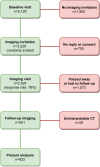Lipoprotein(a) is associated with the onset but not the progression of aortic valve calcification
- PMID: 35869873
- PMCID: PMC9840475
- DOI: 10.1093/eurheartj/ehac377
Lipoprotein(a) is associated with the onset but not the progression of aortic valve calcification
Abstract
Aim: Lipoprotein(a) [Lp(a)] is a potential causal factor in the pathogenesis of aortic valve disease. However, the relationship of Lp(a) with new onset and progression of aortic valve calcium (AVC) has not been studied. The purpose of the study was to assess whether high serum levels of Lp(a) are associated with AVC incidence and progression.
Methods and results: A total of 922 individuals from the population-based Rotterdam Study (mean age 66.0±4.2 years, 47.7% men), whose Lp(a) measurements were available, underwent non-enhanced cardiac computed tomography imaging at baseline and after a median follow-up of 14.0 [interquartile range (IQR) 13.9-14.2] years. New-onset AVC was defined as an AVC score >0 on the follow-up scan in the absence of AVC on the first scan. Progression was defined as the absolute difference in AVC score between the baseline and follow-up scan. Logistic and linear regression analyses were performed to evaluate the relationship of Lp(a) with baseline, new onset, and progression of AVC. All analyses were corrected for age, sex, body mass index, smoking, hypertension, dyslipidaemia, and creatinine. AVC progression was analysed conditional on baseline AVC score expressed as restricted cubic splines. Of the 702 individuals without AVC at baseline, 415 (59.1%) developed new-onset AVC on the follow-up scan. In those with baseline AVC, median annual progression was 13.5 (IQR = 5.2-37.8) Agatston units (AU). Lipoprotein(a) concentration was independently associated with baseline AVC [odds ratio (OR) 1.43 for each 50 mg/dL higher Lp(a); 95% confidence interval (CI) 1.15-1.79] and new-onset AVC (OR 1.30 for each 50 mg/dL higher Lp(a); 95% CI 1.02-1.65), but not with AVC progression (β: -71 AU for each 50 mg/dL higher Lp(a); 95% CI -117; 35). Only baseline AVC score was significantly associated with AVC progression (P < 0.001).
Conclusion: In the population-based Rotterdam Study, Lp(a) is robustly associated with baseline and new-onset AVC but not with AVC progression, suggesting that Lp(a)-lowering interventions may be most effective in pre-calcific stages of aortic valve disease.
Keywords: Aortic valve calcium; Aortic valve stenosis; Cardiac CT; Lipoprotein(a).
© The Author(s) 2022. Published by Oxford University Press on behalf of European Society of Cardiology. All rights reserved. For permissions, please e-mail: journals.permissions@oup.com.
Conflict of interest statement
Conflict of interest: S.S.S., Y.B.R., and E.J.G.S. received funding for the Lp(a) Ahead Study from Amgen Netherlands BV. E.S.G.S. has received research grants/support to his institution from Amgen, Sanofi, Resverlogix, and Athera, and has served as a consultant for Amgen, Sanofi, Esperion, Novartis, and Ionis Pharmaceuticals. All other authors report no conflict of interest.
Figures



Comment in
-
Lipoprotein(a) and aortic valve stenosis: work in progress.Eur Heart J. 2022 Oct 14;43(39):3968-3970. doi: 10.1093/eurheartj/ehac436. Eur Heart J. 2022. PMID: 35979826 No abstract available.
-
Lipoprotein(a) and progression of aortic valve calcification: a case of collider bias?Eur Heart J. 2023 Feb 14;44(7):624-625. doi: 10.1093/eurheartj/ehac638. Eur Heart J. 2023. PMID: 36610068 Free PMC article. No abstract available.
-
Lipoprotein(a) and progression of aortic valve calcification: a case of collider bias? Reply.Eur Heart J. 2023 Feb 14;44(7):626. doi: 10.1093/eurheartj/ehac742. Eur Heart J. 2023. PMID: 36610071 Free PMC article. No abstract available.
References
-
- Eveborn GW, Schirmer H, Heggelund G, Lunde P, Rasmussen K. The evolving epidemiology of valvular aortic stenosis. The Tromsø study. Heart 2013;99:396–400. - PubMed
-
- Iung B, Vahanian A. Degenerative calcific aortic stenosis: a natural history. Heart 2012;98:iv7–iv13. - PubMed
-
- Afshar M, Kamstrup PR, Williams K, Sniderman AD, Nordestgaard BG, Thanassoulis G. Estimating the population impact of Lp(a) lowering on the incidence of myocardial infarction and aortic stenosis—brief report. Arterioscler Thromb Vasc Biol 2016;36:2421–2423. - PubMed
-
- Kamstrup PR, Tybjærg-Hansen A, Nordestgaard BG. Elevated lipoprotein(a) and risk of aortic valve stenosis in the general population. J Am Coll Cardiol 2014;63:470–477. - PubMed
Publication types
MeSH terms
Substances
Supplementary concepts
LinkOut - more resources
Full Text Sources
Miscellaneous

